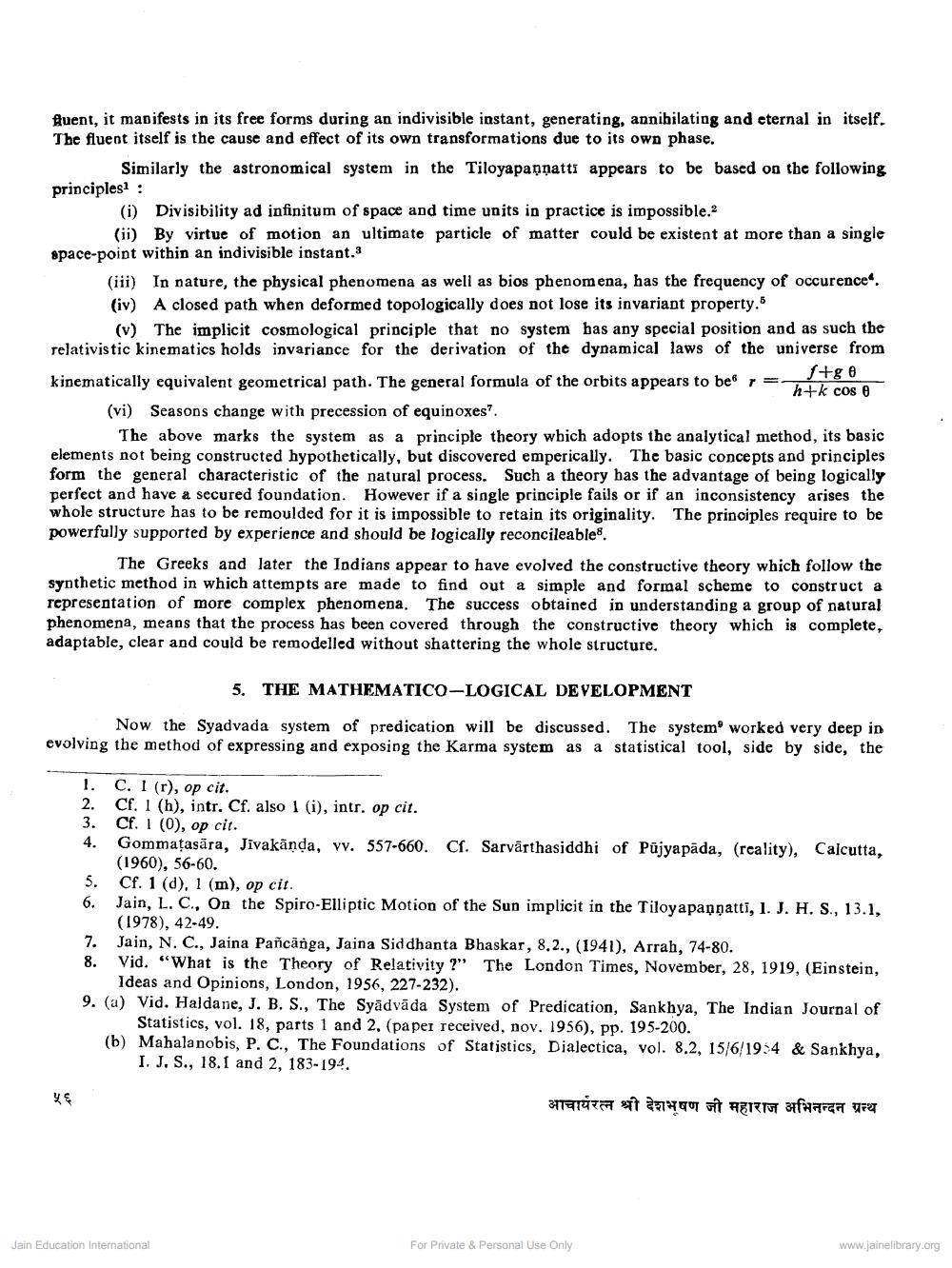Book Title: Jaina Ulterior Motive of Mathematical Philosophy Author(s): L C Jain, C K Jain Publisher: Z_Deshbhushanji_Maharaj_Abhinandan_Granth_012045.pdf View full book textPage 8
________________ fluent, it manifests in its free forms during an indivisible instant, generating, annihilating and eternal in itself. The fluent itself is the cause and effect of its own transformations due to its own phase. Similarly the astronomical system in the Tiloyapaņņatti appears to be based on the following principles : (i) Divisibility ad infinitum of space and time units in practice is impossible. (ii) By virtue of motion an ultimate particle of matter could be existent at more than a single space-point within an indivisible instant.3 (iii) In nature, the physical phenomena as well as bios phenomena, has the frequency of occurence. (iv) A closed path when deformed topologically does not lose its invariant property.5 (v) The implicit cosmological principle that no system has any special position and as such the relativistic kinematics holds invariance for the derivation of the dynamical laws of the universe from f+ge kinematically equivalent geometrical path. The general formula of the orbits appears to be r= h+k cos @ (vi) Seasons change with precession of equinoxes? The above marks the system as a principle theory which adopts the analytical method, its basic elements not being constructed hypothetically, but discovered emperically. The basic concepts and principles form the general characteristic of the natural process. Such a theory has the advantage of being logically perfect and have a secured foundation. However if a single principle fails or if an inconsistency arises the whole structure has to be remoulded for it is impossible to retain its originality. The principles require to be powerfully supported by experience and should be logically reconcileable. The Greeks and later the Indians appear to have evolved the constructive theory which follow the synthetic method in which attempts are made to find out a simple and formal scheme to construct a representation of more complex phenomena. The success obtained in understanding a group of natural phenomena, means that the process has been covered through the constructive theory which is complete, adaptable, clear and could be remodelled without shattering the whole structure. 5. THE MATHEMATICO-LOGICAL DEVELOPMENT Now the Syadvada system of predication will be discussed. The system worked very deep in evolving the method of expressing and exposing the Karma system as a statistical tool, side by side, the 1. C. I (r), op cit. Cf. 1 (h), intr. Cf. also 1 (i), intr. op cit. 3. Cf. I (0), op cit. Gommațasāra, Jivakända, vv. 557-660. Cf. Sarvārthasiddhi of Pujyapāda, (reality), Calcutta, (1960), 56-60. 5. Cf. 1 (d), 1 (m), op cit. Jain, L. C., On the Spiro-Elliptic Motion of the Sun implicit in the Tiloyapannatti, 1. J. H. S., 13.1, (1978), 42-49. 7. Jain, N. C., Jaina Pancanga, Jaina Siddhanta Bhaskar, 8.2., (1941), Arrah, 74-80. 8. Vid. “What is the Theory of Relativity ?" The London Times, November, 28, 1919, (Einstein, Ideas and Opinions, London, 1956, 227-232). 9. (a) Vid. Haldane, J. B. S., The Syadvāda System of Predication, Sankhya, The Indian Journal of Statistics, vol. 18, parts 1 and 2. (paper received, nov. 1956), pp. 195-200. (b) Mahala nobis, P. C., The Foundations of Statistics, Dialectica, vol. 8.2, 15/6/19.4 & Sankhya, I. J.S., 18.1 and 2, 183-194. आचार्यरत्न श्री देशभषण जी महाराज अभिनन्दन ग्रन्थ Jain Education International For Private & Personal Use Only www.jainelibrary.orgPage Navigation
1 ... 6 7 8 9 10 11
